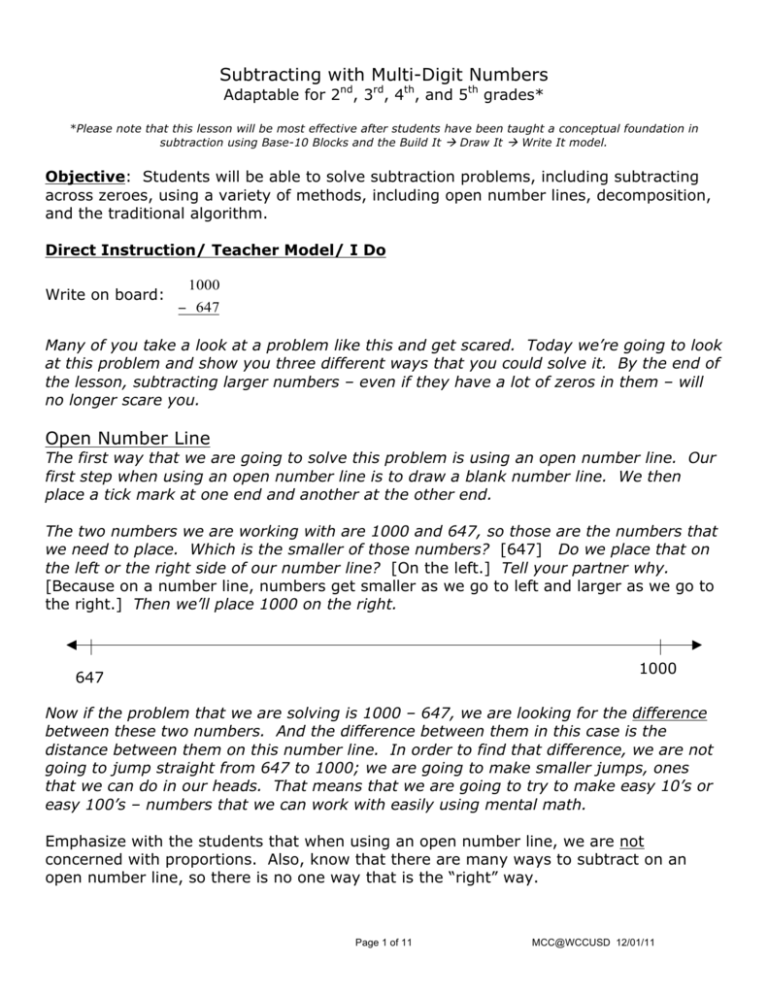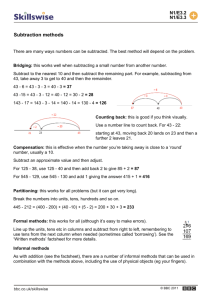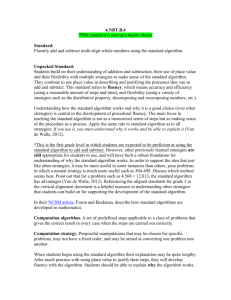Subtracting Whole Numbers
advertisement

Subtracting with Multi-Digit Numbers Adaptable for 2nd, 3rd, 4th, and 5th grades* *Please note that this lesson will be most effective after students have been taught a conceptual foundation in subtraction using Base-10 Blocks and the Build It Draw It Write It model. Objective: Students will be able to solve subtraction problems, including subtracting across zeroes, using a variety of methods, including open number lines, decomposition, and the traditional algorithm. Direct Instruction/ Teacher Model/ I Do Write on board: 1000 − 647 Many of you take a look at a problem like this and get scared. Today we’re going to look at this problem and show you three different ways that you could solve it. By the end of the lesson, subtracting larger numbers – even if they have a lot of zeros in them – will no longer scare you. Open Number Line The first way that we are going to solve this problem is using an open number line. Our first step when using an open number line is to draw a blank number line. We then place a tick mark at one end and another at the other end. The two numbers we are working with are 1000 and 647, so those are the numbers that we need to place. Which is the smaller of those numbers? [647] Do we place that on the left or the right side of our number line? [On the left.] Tell your partner why. [Because on a number line, numbers get smaller as we go to left and larger as we go to the right.] Then we’ll place 1000 on the right. 1000 647 Now if the problem that we are solving is 1000 – 647, we are looking for the difference between these two numbers. And the difference between them in this case is the distance between them on this number line. In order to find that difference, we are not going to jump straight from 647 to 1000; we are going to make smaller jumps, ones that we can do in our heads. That means that we are going to try to make easy 10’s or easy 100’s – numbers that we can work with easily using mental math. Emphasize with the students that when using an open number line, we are not concerned with proportions. Also, know that there are many ways to subtract on an open number line, so there is no one way that is the “right” way. Page 1 of 11 MCC@WCCUSD 12/01/11 I know that to get from 647 to 650 is making a jump of 3. From 650, I know that jumping 50 more will get me to 700. I can jump another 100 to 800, then another 100 to 900, and then another 100 to 1000. I also could have gone straight from 700 to 1000 because I know that’s a jump of 300. 3 50 100 800 700 650 647 100 100 900 1000 From looking at my open number line, I can see that the difference between 1000 and 647 is 3 + 50 + 100 + 100 + 100, or 353. Other possibilities for the same number line: 3 10 667 10 10 10 10 657 1000 700 650 647 647 300 50 677 687 300 3 697 Page 2 of 11 700 1000 MCC@WCCUSD 12/01/11 Decomposition When we’re faced with a problem that scares us, one thing we can do is look for a way to break it down into problems that are easier for us to solve. That’s where decomposition comes in. If trying to subtract 647 from 1000 is hard for me, I’m going to find a way to subtract 647 from something that isn’t as hard for me. 1000 − 647 = 999 + 1 − 647 I can decompose 1000 into 999 + 1. = 352 + 1 = 353 Then I cannot forget to recompose the 1. Then I subtract the 647 from 999. Traditional Algorithm We should still be able to solve this using the traditional algorithm. One reason to save this one for last is that since we have now solved our problem twice, we can check our answer right away to confirm if we used the traditional algorithm correctly. 9 9 10 10 10 1000 − 647 353 • In the ones place, I have 0 minus 7. Since that will give me a negative number, I will try to regroup from the tens place. • In the tens place, I have a 0 and therefore no tens from which to regroup. I will try to regroup from the hundreds place. • In the hundreds place, I have a 0 and therefore no hundreds from which to regroup. I will try to regroup from the thousands place. • In the thousands place, I have 1 thousand which I will regroup into 10 hundreds. That will leave me with 0 thousands and 10 hundreds. But I still don’t have ones with which to subtract. • So now that I have 10 hundreds, I will regroup one of them into 10 tens. That will leave me with 9 hundreds and 10 tens. But I still don’t have ones with which to subtract. • So now that I have 10 tens, I will regroup one of them into 10 ones. That will leave me with 9 tens and 10 ones. • Now I can subtract 7 ones from 10, which gives me 3 ones. • I can subtract 4 tens from 9, which gives me 5 tens. • I can subtract 6 hundreds from 9, which gives me 3 hundreds. • And I have no thousands. • The difference is 353. Once you have determined that you arrived at the same answer all three ways, then you can use the inverse operation to check your answer: 353 + 647 = 1000 Page 3 of 11 MCC@WCCUSD 12/01/11 Guided Instruction/ We Do Example: 3005 − 1879 Open Number Line Write an open number line with two end marks on it. Tell your partner which number is going to be written on which side of the number line. [1879 on the left, 3005 on the right] We’re going to start at 1879 and make logical jumps until I get to 3005. Have the students give you suggestions for the size of the jumps. Below is one way to solve the problem. 1 20 1880 1879 100 1000 2000 1900 5 3000 3005 How will we find the difference between 3005 and 1879? [We will add up all of our jumps.] 1 20 100 1000 + 5 1126 Decomposition 3005 − 1879 = 2999 + 1 + 5 − 1879 = 1120 + 1 + 5 = 1126 I can decompose 3005 into 5 + 2999 + 1. Then I subtract the 1879 from 2999. Then I cannot forget to recompose the 5 and the 1. Page 4 of 11 MCC@WCCUSD 12/01/11 We know that there are different ways to decompose. What is another way in which you could you decompose 3005 to help you solve this problem? [2999 + 6] Page 5 of 11 MCC@WCCUSD 12/01/11 Traditional Algorithm 9 9 2 10 10 15 3005 − 1879 1126 • In the ones place, I have 5 minus 9. Since that will give me a negative number, I will try to regroup from the tens place. • In the tens place, I have a 0 and therefore no tens from which to regroup. I will try to regroup from the hundreds place. • In the hundreds place, I have a 0 and therefore no hundreds from which to regroup. I will try to regroup from the thousands place. • In the thousands place, I have 3 thousands from which I will take 1 and regroup it into 10 hundreds. That will leave me with 2 thousands and 10 hundreds. But I still don’t have ones with which to subtract. • So now that I have 10 hundreds, I will regroup one of them into 10 tens. That will leave me with 9 hundreds and 10 tens. But I still don’t have ones with which to subtract. • So now that I have 10 tens, I will regroup one of them into 10 ones. That will leave me with 9 tens and 10 ones to add to my existing 5 ones. That leaves me with 15 ones. • Now I can subtract 9 ones from 15, which gives me 6 ones. • I can subtract 7 tens from 9, which gives me 2 tens. • I can subtract 8 hundreds from 9, which gives me 1 hundred. • I can subtract 1 thousand from 2, which gives me 1 thousand. • The difference is 1126. Once you have determined that you arrived at the same answer all three ways, then you can use the inverse operation to check your answer: 1126 + 1879 = 3005 Page 6 of 11 MCC@WCCUSD 12/01/11 You Try *There are many different possibilities for the solutions with open number lines and with decomposition. These are simply one example. 4100 – 1975 25 1000 2000 1975 1000 100 4000 3000 4100 25 1000 1000 + 100 2125 10 9 3 0 10 10 3999 + 1 + 100 4100 − 1975 4100 − 1975 = = 2024 + 1 + 100 = 2125 − 1975 2125 Page 7 of 11 MCC@WCCUSD 12/01/11 You Try (continued) 9000 – 3782 8 10 3790 3782 5000 200 4000 3800 9000 8 10 200 + 5000 5218 9000 − 3782 = 8999 + 1 − 3782 = 5217 + 1 = 5218 9 9 8 10 10 10 9000 − 3782 5218 Page 8 of 11 MCC@WCCUSD 12/01/11 Independent Practice/ You Do 502 - 273 7 20 280 273 2 200 500 300 502 7 20 200 + 2 229 9 4 10 12 499 + 1 + 2 502 − 273 − 273 = = 226 + 1 + 2 = 229 502 − 273 229 Page 9 of 11 MCC@WCCUSD 12/01/11 6000 - 428 2 70 430 428 5000 500 1000 500 6000 2 70 500 + 5000 5572 6000 − 428 = 9 9 5 10 10 10 5999 + 1 − 428 = 5571 + 1 6000 − 428 5572 = 5572 5005 – 3156 4 40 3160 3156 1005 800 4000 3200 5005 4 40 800 + 1005 1849 5005 − 3156 = 4999 + 1 + 5 − 3156 = 1843 + 1 + 5 = 1849 9 9 4 10 10 15 5005 − 3156 1849 Page 10 of 11 MCC@WCCUSD 12/01/11 8201 – 7102 1000 98 1 7200 7102 8201 8200 98 1000 + 1 1099 8201 − 7102 7999 + 1 + 201 9 1 10 11 − 7102 = 897 + 1 + 201 8201 − 7102 = 898+1+200 = 1098+1 = 1099 = 1099 9030 – 4468 30 2 4470 4468 500 4500 30 4000 5000 9000 9030 2 30 500 4000 + 30 4562 9 12 8 10 2 10 8999 + 1 + 30 9030 − 4468 9030 − 4468 = − 4468 = 4531 + 1 + 30 = 4562 4562 Page 11 of 11 MCC@WCCUSD 12/01/11





